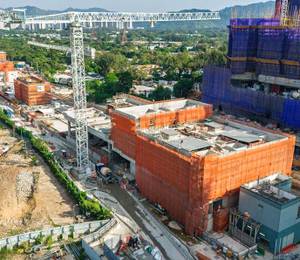Serena Yap has been involved in the engineering and construction industry for almost four decades. Now an executive director for buildings at Aurecon Singapore, she is responsible for managing ongoing projects, taking on the Qualified Person (QP) role, promoting the business and collaborating with clients on various key developments across the country.
“I’ve always enjoyed solving problems, conducting analysis and coming up with solutions. Engineering offers the challenge to solve complex problems and the opportunity to make a positive difference in the world we live in,” she says.
“The industry constantly changes with new technologies, methodologies and materials being invented and I find it enlightening to be constantly learning. To me, engineering is a lifelong journey.”
As a certified Professional Engineer (PE) with expertise in building design, Serena has managed numerous complex, large scale, and award-winning building projects in Singapore and throughout Asia. Her portfolio includes local iconic developments such as The Interlace, Reflections at Keppel Bay, Nanyang Technological University (NTU) Academic Building South, JTC’s Punggol Digital District, plus a variety of data centres, rail projects, community centres and schools.
She reveals what she likes most about engineering and construction: “The idea that humanity needs engineering, just as much as engineering needs humanity is the foundation for designing the most eminent and memorable projects.”
The potential of MET technology
At Aurecon Singapore, Serena started the pioneer team exploring how the company can use mass engineered timber (MET) to create beautiful and sustainable buildings. “I love the warm feeling of comfort and the sense of well-being that timber provides.”
Prior to joining Aurecon, she worked on the construction of a 72-m-long span MET roof for NTU Sports Hall in Singapore.
“Taking lessons learnt from the first project, my team and I are currently working on several MET projects, including JTC’s Punggol Digital District Office, the Rivervale Community Club and Office block and the NTU Academic Building South (ABS). When completed, the NTU ABS will have a gross floor area of 40,000 sq m that will inspire human senses and stimulate learning.”
She points out that MET used as a material in construction today has the potential to disrupt the construction industry, in the same way that plastic transformed the manufacturing industry in the early 1900s.
“Nevertheless, disruption is not new to engineers,” she says.
“As we look to the future with more timber construction, we must embrace disruption and lead the change by adopting new technologies, methods of designing, constructing, and engineering while placing the human experience in the front and centre of the projects.”
‘Always be open minded and proactive’
When asked about her experience working in a male-dominated environment, Serena says, “When I was a young engineer, it took more effort to convince my fellow colleagues or working partners on the projects we delivered.
“Working my way up and having been in the consultancy business all this while, being a female engineer has not made it more challenging. Instead, it can be advantageous at times as male engineers and stakeholders can be more tolerant and polite.
“Regardless of gender, I find it important to cultivate mutual respect among colleagues and my team to ensure we deliver the best for our clients.”
Serena further shares her encouraging advice for anyone aspiring to pursue careers in engineering: “The industry is always open to passionate individuals who want to make a difference in the world we live in.
“To be an engineer, one must enjoy taking things apart and putting it back together, thrive on problem solving and always on the lookout for opportunities to learn.”
“Apart from gaining technical skills, the exposure of working with multiple stakeholders and colleagues will help you build soft skills and confidence in your capabilities,” she adds. “This is crucial especially when convincing clients that what you have proposed is the optimal solution.”
Her final message? “Always remain open minded, be proactive not reactive, and adopt design-led thinking – focusing on the user’s needs, challenges the stakeholders are facing, and clearly defining those needs before tackling the problem. This approach will enable you to focus on creating innovative solutions that best suit those needs.”
Photos courtesy of Serena Yap and Aurecon












